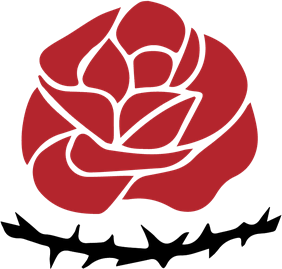
Mohammad Mosaddegh was the 35th prime minister of Iran, holding office from 1951 until 1953, when his government was overthrown in a coup d'état orchestrated by the United States' Central Intelligence Agency and the United Kingdom's MI6.

The Iranian parliamentary elections of February 20 and May 7, 2004 were a victory for Islamic conservatives over the reformist parties. Assisting the conservative victory was the disqualification of about 2500 reformist candidates earlier in January.

The Tudeh Party of Iran is an Iranian communist party. Formed in 1941, with Soleiman Mohsen Eskandari as its head, it had considerable influence in its early years and played an important role during Mohammad Mosaddegh's campaign to nationalize the Anglo-Persian Oil Company and his term as prime minister. The crackdown that followed the 1953 coup against Mosaddegh is said to have "destroyed" the party, although it continued. The party still exists, but has remained much weaker as a result of its banning in Iran and mass arrests by the Islamic Republic in 1982, as well as the executions of political prisoners in 1988.
Parliamentary elections were held in Iran on 18 February 2000, with a second round on 5 May. The result was a solid victory for 2nd of Khordad Front and its allies, the reformist supporters of President Mohammad Khatami.
Ettehadiyeh-ye Sendika-ye Kargaran-e Iran was a trade union centre in Iran. It was founded on the initiative of the Ministry of Labour and Propaganda in September 1946, with the explicit purpose of competing with the Tudeh-led Central United Council of the Trade Unions of Workers and Toilers of Iran (CUC). The task of setting up ESKI had been delegated to Mehdi Sharif-Emami, the director of the Dispute Settlement Department of the Ministry of Labour and Propaganda. ESKI published the newspaper Kargaran-e Iran. ESKI was a founding member of the International Confederation of Free Trade Unions.
Ardashes "Ardeshir" Ovanessian (1905–1990) was an Iranian communist leader of Armenian origin.
The Central Council of United Trade Unions was a trade union centre in Iran.
Rahbar was an Iranian Persian language daily newspaper, published from Tehran. It was the central organ of the communist Tudeh Party of Iran. The decision to launch Rahbar was taken at the First Party Conference held in October 1942, after that Abbas Iskandari, the editor of erstwhile central organ of the party Siasat, had been expelled from the party. In the initial phase of Rahbar the Tudeh Party was not officially a communist party, and the editorial line of the newspaper was non-communist constitutionalism. During the years of the Second World War, Rahbar focused on anti-fascist and pro-peace agitation.

Parliamentary elections were held in Iran on 13 March 1980, with a second round on 9 May. They were the first elections to the Majlis since the overthrow of the Shah, and were contested to a considerable degree on a party basis.

Parliamentary elections were held in Iran in 1952 to elect the 17th Iranian Majlis.

Constitutional Convention elections were held in Iran on 3 and 4 August 1979. The result was a victory for the Islamic Republican Party. 10,784,932 voted in the elections, marking 51.71% turnout. Of all members elected, 68% were clerics.
The Comrades Party was a left-wing Iranian political party active during the 1940s. The party was part of a wave of political groupings established in the early 1940s following the removal of Rezā Shāh.
The elections for the sixth Majlis ended on 27 June 1926.

In the elections for the seventh Majlis, systematically rigged by the military and Interior ministry, handpicked representatives of Reza Shah were chosen to the parliament to ensure the exclusion of recalcitrants and "unsuitable candidates who insisted on running found themselves either in jail or banished from their localities".
This is an overview of the Iranian legislative election, 1980 in Tehran, Rey and Shemiranat electoral district.
Iranian Democrat Party or Democrat Party of Iran was a short-lived political party in Iran, founded in 1946 and led by Ahmad Qavam. It was the most important party formed by the old Qajar nobility, and an association of aristocrats and anti-British radical intellectuals. With the fall of Qavam, it disintegrated in 1948.

Socialism in Iran or Iranian socialism is a political ideology that traces its beginnings to the 20th century and encompasses various political parties in the country. Iran experienced a short Third World Socialism period at the zenith of the Tudeh Party after the abdication of Reza Shah and his replacement by his son, Mohammad Reza Pahlavi. After failing to reach power, this form of third world socialism was replaced by Mosaddegh's populist, non-aligned Iranian nationalism of the National Front party as the main anti-monarchy force in Iran, reaching power (1949–1953), and it remained with that strength even in opposition until the rise of Islamism and the Iranian Revolution. The Tudehs have moved towards basic socialist communism since then.

Seyyed Hassan Emami was an Iranian Shia cleric and royalist politician. He worked as a judge in the Ministry of Justice and taught law at University of Tehran.
Prime Minister Ahmad Qavam formed a short-lived coalition government on 1 August 1946 with his Democrat Party of Iran and the left-wing Tudeh Party and Iran Party. He offered three portfolios to the communists and gave the ministries of finance and communications to two royalists; while maintained his own control over interior and foreign ministries.

Noureddin Alamouti was an Iranian judge and politician. He served as the justice minister under cabinet of Ali Amini, during which he was noted for forming a powerful anti-corruption division that led to "the last serious attempt to realize the rule of law" in Pahlavi dynasty.
















